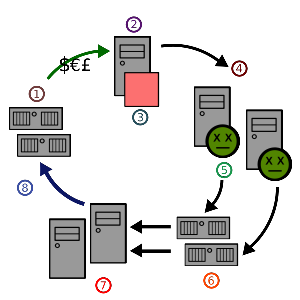英乐博客
学习英语,欣赏音乐。
正文
A zombie computer (often abbreviated zombie) is a computer attached to the Internet that has been compromised by a Hacker, a computer virus, or a trojan horse. Generally, a compromised machine is only one of many in a "botnet", and will be used to perform malicious tasks of one sort or another under remote direction. Most owners of zombie computers are unaware that their system is being used in this way. Because the vector tends to be unconscious, these computers are metaphorically compared to a zombie.
Zombies have been used extensively to send e-mail spam; as of 2005, an estimated 50–80% of all spam worldwide was sent by zombie computers.[1] This allows spammers to avoid detection and presumably reduces their bandwidth costs, since the owners of zombies pay for their own bandwidth.
For similar reasons zombies are also used to commit click fraud against sites displaying pay per click advertising. Others can host phishing or money mule recruiting websites.
Zombies have also conducted distributed denial of service attacks, such as the attack upon the SPEWS service in 2003, and the one against Blue Frog service in 2006. In 2000, several prominent Web sites (Yahoo, eBay, etc) were clogged to a standstill by a distributed denial of service attack mounted by a Canadian teenager. An attack on grc.com is discussed at length, and the perpetrator, a 13-year old probably from Kenosha, Wisconsin, identified on the Gibson Research Web site. Steve Gibson disassembled a 'bot' which was a zombie used in the attack, and traced it to its distributor. In his clearly written account about his research, he describes the operation of a 'bot' controlling IRC channel.[2]
References
1. ^ Tom Spring, Spam Slayer: Slaying Spam-Spewing Zombie PCs, PC World, 2005-06-20
2. ^ Steve Gibson, The Attacks on GRC.COM, Gibson Research Corporation, first: 2001-05-04, last: 2005-09-17
2. ^ Steve Gibson, The Attacks on GRC.COM, Gibson Research Corporation, first: 2001-05-04, last: 2005-09-17
Retrived from: http://encyclopedia.thefreedictionary.com/zombie+computer
评论
目前还没有任何评论
登录后才可评论.





